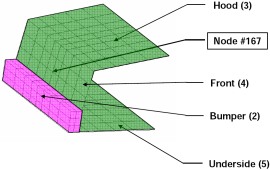Direct Optimization
In this example a direct optimization method, the Genetic Algorithm, is used instead of a metamodel-based approach to solve the optimization problem explained in Crashworthiness Optimization.
The problem is of a simplified vehicle moving at a constant velocity and crashing into a pole.
 |
 |
| Fig. 1(a): Deformed vehicle after 50 ms | Fig. 1(b): Design variables with part numbers |
The problem illustrates the following features:
|
The criteria of interest are the following:
Design variables:
|
Design Formulation
The design formulation is as follows:
- Minimize HIC(15 ms) subject to Intrusion (50 ms) < 550 mm and mass < 0.5. The intrusion is measured as the distance between the nodes 167 and 432 (for the location of the nodes see Fig. 1).
